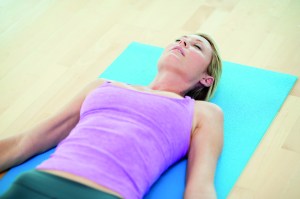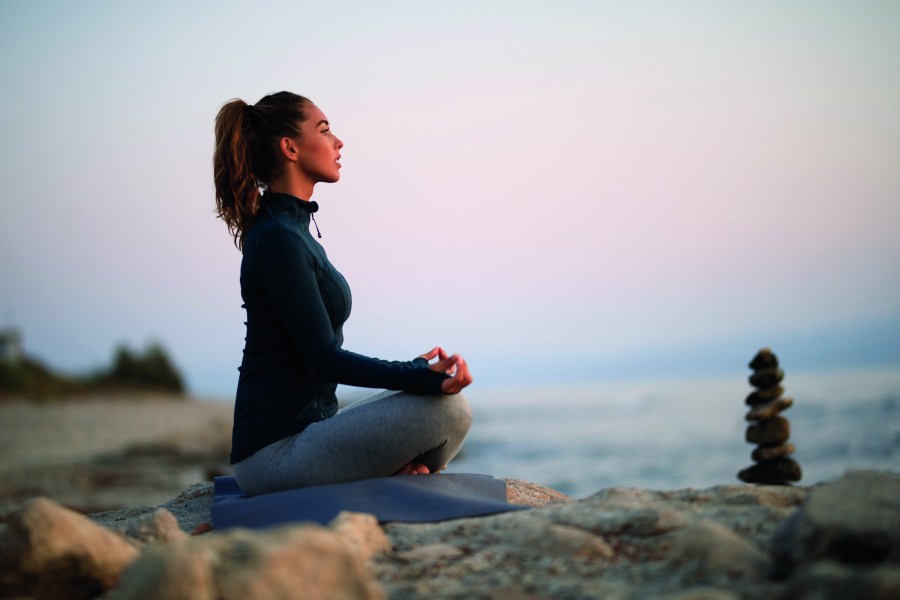Harness the power of your breath to boost energy, calm nerves, increase focus and nourish your whole system. Words: Jean Hall
At any given time, the breath has an amazing capacity to respond to and support our changing needs immediately. When we hear soothing music, see someone we love or a beautiful landscape, our breathing responds by softening and deepening. If we hear sad or bad news, we are likely to hold our breath, or, when we’re in an awkward situation, whether emotionally or physically, we tend to tighten the breath.
Nurturing our ability to return the breath to its deep and natural flow after a challenging experience – for example, when the breath has quickened – is essential to creating healthy breathing. If the breath gets stuck in a particular pattern, it is no longer responsive and supportive to our varied life. Developing awareness of our breath helps to release our breathing patterns, so that we can breathe well again.
When we allow the breath to flow deeply and fully through our bodies, we begin a chain reaction for positive change and health. The benefits of breathing mindfully, naturally and deeply are all-encompassing:
- The body relaxes and begins to release tension, allowing for greater absorption of oxygen into every cell. This creates energy and improves the functionality of all the bodily systems, in particular the circulatory, immune, muscular, endocrine, digestive, nervous and cardiovascular systems.
- The nervous system is balanced by the stimulation of the parasympathetic branch (the ‘rest and digest’ system). It helps to calm and slow the heart rate, conserving energy and enhancing the body’s natural ability to heal and recuperate. The parasympathetic system also improves gastrointestinal activity and healthy digestion.
- The heart rate lowers, the muscular system releases tension and the blood vessels are able to dilate, allowing for improved circulation and lowered blood pressure.
- Oxygen flowing to the brain increases, heightening mental clarity, concentration and stamina and promoting fuller awareness and mindfulness. With increased mindfulness, we are able to notice patterns of tension and behaviour that do not serve us well. These can then be addressed and changed to enhance the relationship we have with ourselves and others.
- The mind can calm and become focused, pent-up emotion and tension can release and stress hormones are lowered, in particular adrenalin and cortisol. These hormones are known to suppress the immune system.
By becoming aware of our breath and receiving its natural flow, we can transform how we perceive, think, feel, boost energy, experience and respond to life. The ancient yogis realised this and they devised a system of deep-breathing practices called pranayama, which translates from Sanskrit as ‘extension of life energy’. The following breathing practices all stem from the yoga tradition and help to return the breath to its natural and optimum pattern that is full, deep and responsive to life and can help boost energy.

Balancing breath
In this practice, the flow of your breath is consciously guided in all directions to help lung capacity and cultivate a deep sense of equilibrium and calm within.
- Lie on the floor in a comfortable position. Breathe softly and fully, relaxing into the natural flow of your breath.
- Sense the cool air entering your nostrils, gently guiding the breath equally in through the right and left nostril and evenly back out again. Take five more breaths.
- Now, focus on balancing the length of your in- and out-breaths, letting them be easy, relaxed and equal.
- Next, bring attention to balancing the strength of the in- and out-breaths, so that one is not more dominant than the other. Take a few breaths here, levelling the length and strength of each inhalation and exhalation.
- Now, gently breathe evenly into the bottom and then into the top of your lungs and back out again (from the top and then the bottom of your lungs). Take a few more breaths here, feeling the depth and height of your lungs.
- Bring awareness to the sides of your torso, breathing evenly into the sides of your lungs, the outer sides by your arms and the inner sides by your spine. Breathe in and out slowly and gently, feeling the breadth of your lungs.
- Widen your attention to the front and back of your body and breathe evenly into the front and back of your lungs. Feel the front and back of your ribcage expand and open with each inhalation and release with each exhalation. Breathe here, feeling the floor beneath you and the space above you.
- Finally, cultivate an even smoothness at the beginning and ending of each inhalation and each exhalation.
- Take a few more breaths here, enjoying the sense of balance and space in your body, mind and breath.

10 tips to boost your energy this summer
Kapalabhati
This practice* will stoke your inner fire and help to invigorate the abdominal organs, aid digestion and tone the core muscles. It improves oxygen circulation through your whole body, particularly to the brain to boost energy.
- Begin in a comfortable, seated position. Feel your pelvis rooting into the earth and your spine lengthening up to the sky. Allow your body to soften and release tension.
- Place your palms to rest gently against your lower belly, with your thumbs level with your navel.
- Relax your facial muscles, let your eyes close and enjoy a few steady, deep breaths. On your next exhalation, powerfully draw your abdomen in and up, away from your hands, to expel the breath swiftly.
- Now release your belly so the inhalation can pour in without effort, allowing your belly to make contact with your hands again.
- Continue this for another nine times. These 10 breaths make up one round of Kapalabhati.
- Practise three-to- five rounds, taking a couple of easy and natural breaths between each round.
- To round off the practice, sit quietly with your eyes closed, allowing your breath to return to its natural flow, bringing your awareness to your eyebrow centre and feeling an open calmness enveloping your whole body and mind.
* Do not practise kapalabhati if pregnant or during menstruation, if you have high-blood pressure, a hernia, lung disease, a gastric ulcer, diarrhoea or if you experience dizziness or anxiety.

Ujjayi
This is a traditional yogic technique** with a multitude of benefits. The soft, oceanic sound created enables us to hear the flow of our breath, helping to harness and focus the mind and boost energy. Perhaps the most noted benefit is that it intensifies the flow of energy throughout the whole body.
- Stand tall with ease. With your feet hip-width apart, legs and feet parallel and toes pointing forwards, spread your weight evenly across your feet and let the soles open into the ground. Lengthen along your spine, allowing your crown to rise and
your tail bone to release down. Relax your arms by your sides and soften your shoulders away from your ears. Relax and soften your facial muscles, let your eyes close and settle here, becoming aware of your breath. - As you inhale through your nose, feel the natural flow of your breath rising through you as you breathe in, and washing back down as you breathe out. Feel its fluid rhythm and energy flowing through your whole body.
- Open your eyes and bring your hands up approximately 20cm in front of you, palms facing towards you, elbows bent and soft. Imagine your hands are a mirror.
- Open your mouth slightly, then slowly and fully exhale through your mouth making a smooth ‘haaaaa’ sound, as if you are fogging up a mirror. Let the breath out completely.
- Inhale through your mouth creating a soft ‘ahhhhh’ sound, as if defogging the mirror. Let each breath be full, deep and steady in both sound and feel.
- Continue breathing in this way and, as you inhale, gently sway your weight forwards towards your toes, opening your arms up and out to the sides like wings unfolding. As you exhale, rock your weight back to your heels and return your hands in front of your mouth to fog the mirror. If you prefer to do the practice seated, you can lean forwards as you inhale and draw back to centre as you exhale.
- Feel your chest and heart lifting and opening with each inhalation, and the belly softly pouring in and up on each exhalation.
- Breathe here for a few moments and gradually close your mouth so you are breathing through your nose, while still making this soft oceanic ‘ahhhhh’ sound on the in-breath, and ‘haaaaa’ sound on the out-breath.
- Let the motion of your arms and sway of your body lessen and slowly diminish so that you are breathing in stillness with your arms relaxed by your sides.
- Remain here for a few more moments, enjoying the calm and flow.
Extract taken from Breathe by Jean Hall (Quadrille, £14), available now. Illustrations © Georgie McAusland








